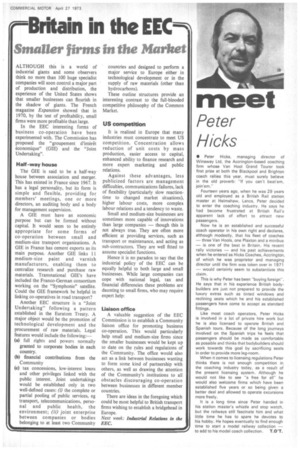ec - -Britain in the EECa- -- mm•,
Page 39

If you've noticed an error in this article please click here to report it so we can fix it.
Smaller firms in the Market
ALTHOUGH this is a world of industrial giants and some observers think no more than 100 huge specialist companies will soon control a major part of production and distribution, the experience of the United States shows that smaller businesses can flourish in the shadow of giants. The French magazine Expansion showed that in 1970, by the test of profitability, small firms were more profitable than large.
In the EEC interesting forms of business co-operation have been experimented with. The Commission has proposed the "groupement d'interet economique" (GIE) and the "Joint Undertaking".
Half-way house The GIE is said to be a half-way house between association and merger. This has existed in France since 1967. It has a legal personality, but its form is simple and flexible, providing for members' meetings, one or more directors, an auditing body and a body for management supervision.
A GIE must have an economic purpose but can be formed without capital. It would seem to be entirely appropriate for some forms of co-operation between small and medium-size transport organizations. A GIE in France has cement exports as its main purpose. Another GIE links 11 medium-size paint arid varnish manufacturers, enabling them to centralize research and purchase raw materials. Transnational GIE's have included the Franco-German consortium working on the "Symphonic" satellite. Could the GIE framework be helpful in linking co-operatives in road transport?
Another EEC structure is a "Joint Undertaking" following a pattern established in the Euratom Treaty. A major object would be the promotion of technological development and the procurement of raw materials. Legal features would include the following:—
(a) full rights and powers normally granted to corporate bodies in each country.
(b) financial contributions from the Community
(c) tax concessions, low-interest loans and other privileges linked with the public interest. Joint undertakings would be established only in two well-defined cases: the complete or partial pooling of public services. eg transport, telecommunications, personal and public health, the environment; (ii) joint enterprise between companies or bodies belonging to at least two Community countries and designed to perform a major service to Europe either in technological development or in the supply of raw materials (other than hydrocarbons).
These outline structures provide an interesting contrast to the full-blooded competitive philosophy of the Common Market.
US Competition It is realized in Europe that many industries must concentrate to meet US competition. Concentration allows reduction of unit costs by mass production, easier access to capital. enhanced ability to finance research and more expert marketing and public relations.
Against these advantages, less publicized factors are management difficulties. communications failures, lack of flexibility (particularly slow reactiontime to changed market situations). higher labour costs, more complex labour relations and a tendency to waste.
Small and medium-size businesses are sometimes more capable of innovations than large companies — though this is not always true. They are often more efficient at providing services, such as transport or maintenance, and acting as sub-contractors. They are well fitted to assume specialist functions.
Hence it is no paradox to say that the industrial policy of the EEC can be equally helpful to both large and small businesses. While large companies can cope with national legal, tax and financial differencies these problems are daunting to small firms, who may require expert help: Liaison office A valuable suggestion of the EEC Commission is to establish a Community liaison office for promoting business co-operation. This would particularly help small and medium-size firms since the smaller businesses would be kept up to date on the rules and regulations of the Community. The office would also act as a link between businesses wanting to form some kind of partnership with others, as well as drawing the attention of the Community's institutions to all obstacles discouraging co-operation between businesses in different member countries.
There are ideas in the foregoing which could be most helpful to British transport firms wishing to establish a bridgehead in Europe.
Next week: Industrial Relations in the EEC.












































































































